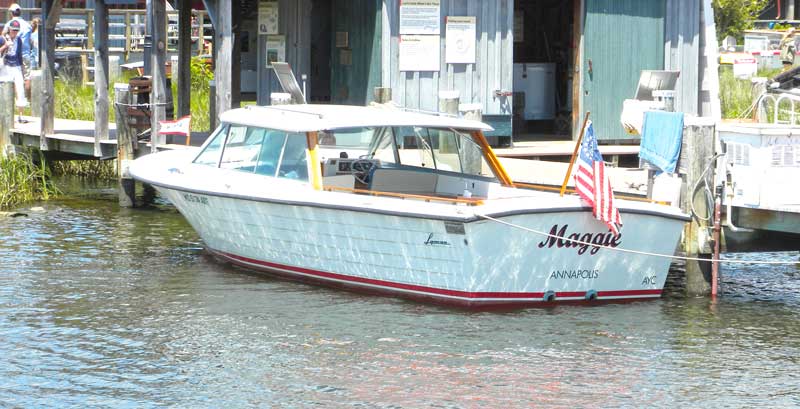As we dropped lines from Pocahontas Marina (for more on Pochahontas Marina, check out our Boatshop Reports) in Edgewater, MD, and headed towards Thomas Point, the bow of the boat split the waves and chop with a sense of assurance. We were starting our smooth ride near Selby Bay, at the head of the South River. It was a breezy and sunny day, ideal for our hardtop boat with its versatile windshield. Opening it to let in the breeze, we had protection from the sun along with a comfortable flowing wind as we cruised north.

We were riding in Hank Reiser’s fiberglass Lyman Late Classic (1978) Cruisette model. She is a hardtop weekender with berths for two and a porta-potty under the foredeck. Covered by the hardtop is an icebox, sink, and meal prep space that functions as a wet bar and galley, along with a dinette that seats four or converts to a sleeping area for two. Since the cockpit is open and roomy except for the single engine box, there is also room for a couple of deck chairs.
She is powered by a 225-hp Chrysler inboard shaft drive that cruises at 2800 rpm. Although the boat has a separate rudder but no bow thruster, Hank had no trouble handling her into and out of her slip.
A fiberglass hull and deck Lyman is an all-fiberglass boat built from a wooden Lyman model (plug). Lyman originally made this 26-foot model using traditional wood boat-building techniques and decided by the ‘70s that a fiberglass model would be competitive in the marine marketplace. So they took one of their recently completed wooden boats, turned it upside down, and made a mold for their future fiberglass 26-foot Lymans.
In other words, a fiberglass Lyman and a wood Lyman are the same in the shape of their hulls. They may not ride exactly the same, however. In a wood Lyman, wood planks wiggle a little as the boat moves over the wakes and through the chop. But a fiberglass Lyman does not. Her hull is essentially stiff and inflexible, like all other fiberglass boats.
Nonetheless, we had a nice ride in this fiberglass version of Lyman’s traditional lapstrake round-chine boat. Notice that the position of each original wooden plank is molded into the running surface of the fiberglass and displays proud on the hull, providing lift to support the boat on plane.
Lyman Boat Works started in 1875, co-founded by Bernard and Herman Lyman. Early models ranged from rowboats as small as 13 feet to a 65-foot sailboat. All were clinker-built wood boats: designed and constructed with one plank edge proud over the plank below. Tom Koroknay calls this technique “mastering the rugged chop of Lake Erie.”
Around 1918, Lyman Boat Works was making 11-, 13-, and15-foot lengths. These were both row and outboard powered boats. One outboard, the Lock Wood Ace motor, mated up with 18-mph speeds. Other outboard brands were also available.
By 1920 Bernard’s son, Bill, joined the family business. He moved the factory in 1932 from Cleveland into a new 18,000-square-foot building in Sandusky, OH. Bill saw to it that inboard powered boats, several outboard motor-powered models, and a few custom cabin cruisers were built. The Lyman brand of wooden boats grew in popularity during the ‘50s and ‘60s and continued into its fiberglass transition in the 70s. Although the company no longer exists, the brand is still well known thanks to the loyalty of Lyman boat owners.
With a compass heading of about 345 degrees and then 005 degrees, we cruised to just north of the Severn River. From there we eyeballed it into Whitehall Bay, passing the red marker closely to port to miss both the North Shoals that it marks and the Whitehall Flats that lie to the South.
Our destination was a Chesapeake Bay Chapter of the Antique and Classic Boat Society Spring Raft Up event titled “Blow the Carb.” We were a group of nine boaters who brought four classic powerboats to this event: a 15-foot outboard powered boat, a 42-foot Chesapeake Deadrise, a 23-foot Lyman “sleeper,” and this 26-foot Lyman “Cruisette.” We tied up together to the anchors of the deadrise to talk, eat, and swim on a glorious afternoon.
By Chris "Seabuddy" Brown